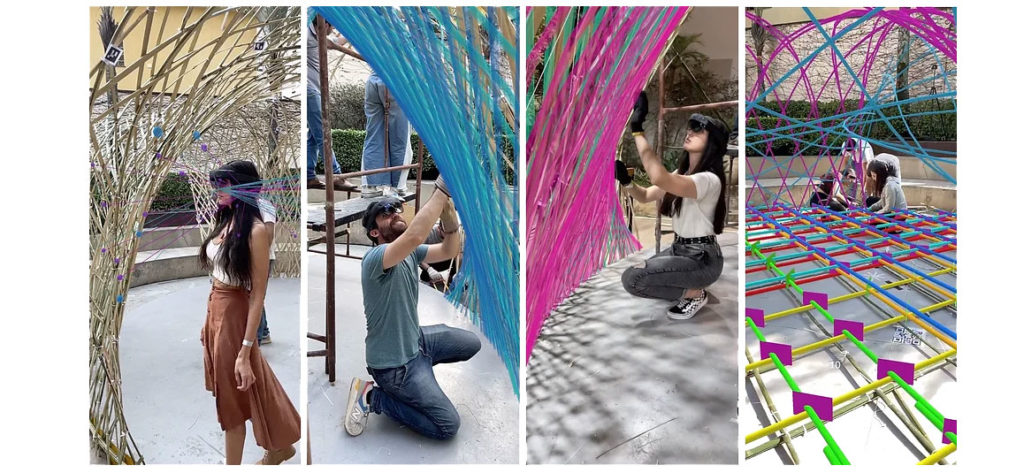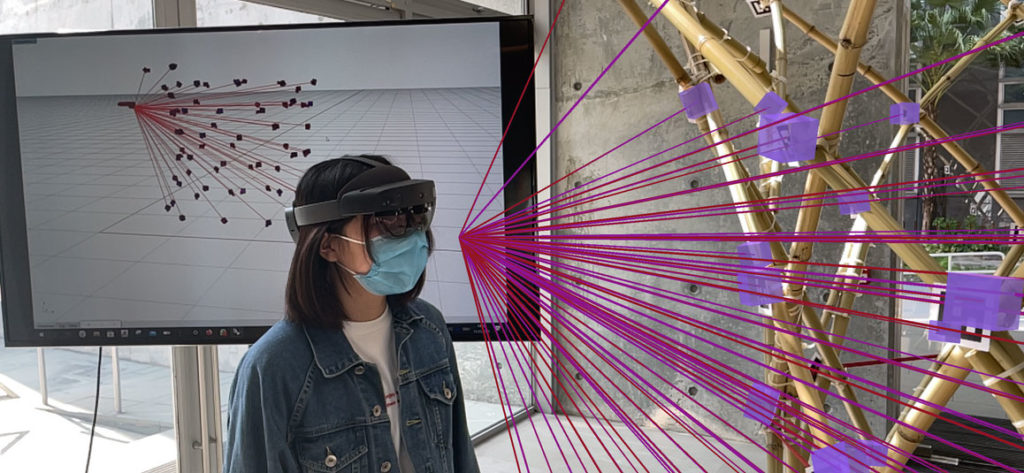Link to Podcast
Link to Transcript
Background Music: DJ Shadow – Organ Donor
- Reality (R) – Real background with no virtual objects in foreground
- Virtual Reality (VR) – Virtual background with virtual objects in foreground
- Augmented Reality (AR) – Real background with virtual objects in foreground
- Mixed Reality (MR) – Real background with virtual objects in foreground. The virtual objects are able to see and react to objects in reality such as avoiding collision.
Extended Reality (XR) alters between R, VR, AR, and MR as required. It can be visualized through immersive goggles or any phone or tablet. Used by engineers and contractors for simple clash detection and checking on-site inventory, but there is also a new opportunity for architects to control advanced on-site fabrication and complex assembly to further advance architecture. We are joined by Kristof and Garvin who have produced a body of work that is at the cutting edge of rethinking craftsmanship around assembly in XR.
Interview Guests
Kristof Crolla and Garvin Goebel
Kristof and Garvin have collaborated on a number of projects together involving assembly with extended reality (XR). They are research-orientated architects using Augmented Reality, Mixed Reality, and Virtual Reality to create their projects. They can be found at the Building Simplexity Lab at the University of Hong Kong (HKU) that contains their publications and tutorials. Kristof founded the Laboratory for Explorative Architecture and Design and is Assistant Dean of Architecture at University of Hong Kong (HKU). Garvin is almost finished with his Ph.D. from the Chinese University of Hong Kong and can be found online at Augmented Architecture and on Instagram. Together, they are leading the upcoming AA Visiting School in Brazil 2023 that will focus on XR.
In our episode, Kristof and Garvin discuss their experience working with Hololens, Fologram, and TwinBuild to create complex structures in bamboo. They reveal what is and is not working well in XR. They answer how and why they decided to focus on this technology and outline the opportunity that XR offers us today as well as in the near future.
“We experimented with the idea of buildings co-existing with digital and physical content to create a mixed reality where the boundaries between the digital and physical worlds are blurred…”
Garvin Goebel

Interview Questions
- You just finished a workshop in Bali. Can you tell us about how that went and what you were doing there?
- What did your students struggle with most and what did they find the most rewarding?
- I assume that you’re both long term fans of technology and advanced computation in architecture knowing how to navigate the most complex software and plugins. When did you decide to focus on extended reality and what was the learning curve like in order to create your first few projects that used XR?
- What software and hardware do you currently use to create your projects and will any soon-to-be released newer software and hardware improve your process in any way?
- Your bamboo projects would be difficult to do without this technology. What other materials and assembly processes have you worked on or seen elsewhere that are dependent on the use of extended reality for assembly?
- Modern construction created a canyon between designers and makers whereas digital fabrication created a bridge for designers to have direct control over the tools of making . How does extended reality change designers sitting at their desk’s relationship to making?
- I’ve heard it said that pavilions are prototypes to resolve the challenge of working with complex geometry and new technologies so that they can be scaled up to much larger buildings later on. Are large projects made using extended reality in your future? And what do you think the challenges of scaling up will be?
- Garvin, you’ve said on your website, “Augmented construction workflows suggest future abilities to democratize skill through simple and intuitive holographic instructions that do not require professional training.”. Could you elaborate on the who, the where, and the why that you see the opportunity for this expanded audience?
- Kristof, you talked about the difference between corner-cutting and craftsmanship in your Ph.D. comparing Cha Bu Duo” (???)with Richard Sennett. How does working with contractors, builders, and craftspeople at these extremes influence the design of your projects? And how does XR play a role here?
- Your project, Resonance-in-Sight is an arch that begins on both ends in reality leaving the middle unfinished. Viewers overlay a virtual layer completing the arch in augmented reality. Does everyone see the same virtual objects? And is this an opportunity for libraries of content to customize the experience for different groups? Related to BIM, how much of an overlap is there between work done for an AR experience and work done for AR assembly?



“Augmented reality allowed us to directly communicate construction processes on site which dramatically reduced the complexity associated with non-standard architecture.”
Kristof Crolla
Conclusion
Kristof and Garvin clearly demonstrated how Mixed Reality (MR) has proven to be an incredibly useful tool for assisting in the construction of non-standard architecture on site. By overlaying digital models onto the real world, architects and construction workers can visualize the finished product and adjust as needed. This technology has allowed for greater precision and efficiency, leading to reduced construction time and cost.
While MR has proven to be a valuable tool for construction, there are still limitations to its use. The technology relies heavily on the accuracy of the digital models and the ability to track movement and location in real-time. Large scale projects such as hospitals have yet to be tested with this technology. However, as it continues to evolve, the potential for MR in construction is enormous. Future advancements could include the ability to manipulate digital models in real-time, allowing for greater flexibility and creativity in the design process. MR could also be integrated with other emerging technologies such as artificial intelligence and robotics to create a fully automated and streamlined construction process. As these advancements become more accessible, the use of MR in construction is likely to become even more widespread and transformative.
Final Crit Presentation
The final crit included guest critic Alex Mademochoritis (IAAC) who wasn’t that excited about XR because the technology has been around for decades without ever becoming mainstream. Looking at other technologies, it is important to see the entire history and not just the latest boom. ChatGPT’s underlying technology dates back to the Hidden Markov Model (HMM), first introduced in the 1960’s or even further back to the n-gram models of the 1950’s that measured the probability of a word occurring in a sentence. Google was founded in 1998 entering the highly aggressive “search wars” but computational search also goes back to the 1950’s with John McCarthy’s “Advice Taker,” or to the first search engine from 1990 by McGill University. We do not think XR should be judged by the amount of time that it takes to find its lift-off as many technologies take decades to spark. Instead, a technology should be analyzed in the here and now and whether it solves a problem worth solving. Our podcast guests Kristof and Garvin explore in great detail what XR offers us today. It offers the right amount of information in the right place at the right time. As the cost of XR comes down, the world can iteratively re-evaluate whether the advantages of XR are worth scaling up.

